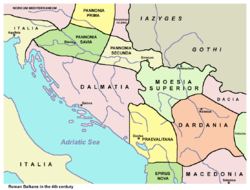This is an old revision of this page, as edited by Golikom (talk | contribs) at 02:14, 14 September 2024 (Undid revision 1245583278 by Maleschreiber (talk) this includes a load of unsourced conjecture. By all means restore it with sources). The present address (URL) is a permanent link to this revision, which may differ significantly from the current revision.
Revision as of 02:14, 14 September 2024 by Golikom (talk | contribs) (Undid revision 1245583278 by Maleschreiber (talk) this includes a load of unsourced conjecture. By all means restore it with sources)(diff) ← Previous revision | Latest revision (diff) | Newer revision → (diff) Group of Roman emperors
The Illyriciani or Illyrian emperors were a group of Roman emperors during the Crisis of the Third Century who were of Illyrian origins and hailed from the region of Illyricum (in the Western Balkans), and were raised chiefly from the ranks of the Roman army (whence they are ranked among the so-called "barracks emperors").
In the 2nd and 3rd centuries, the Illyricum and the other Danubian provinces (Dacia, Raetia, Pannonia, Moesia) held the largest concentration of Roman forces (12 legions, up to a third of the total army), and were a major recruiting ground. The advance of these low-born provincials was facilitated by a major shift in imperial policy from the time of Gallienus (253–268) on, when higher military appointments ceased to be exclusively filled by senators. Instead, professional soldiers of humble origin who had risen through the ranks to the post of primus pilus (which also entailed admission to the equestrian order) were placed as heads of the legions and filled the army's command structure.
Since Decius hailed from the senatorial background, the historical period of the Illyrian emperors proper begins with Claudius Gothicus in 268 and continues in 284 with the rise of Diocletian and the institution of the Tetrarchy. This period was very important in the history of the Empire, since it represents the recovery from the Crisis of the Third Century, a long period of usurpations and military difficulties.
The later Valentinian (364-392 and 425–4575 AD) also hailed from the Pannonia region.
List
The following emperors are counted as Illyriciani:
- Decius, ruled AD 249–251
- Herennius Etruscus, ruled AD 251
- Hostilian, ruled AD 251
- Claudius Gothicus, ruled AD 268–270
- Quintillus, ruled AD 270
- Aurelian, ruled AD 270–275
- Probus, ruled AD 276–282
- Diocletian, ruled AD 284–305
- Maximian, ruled AD 286–305
- Constantius Chlorus, ruled AD 305–306
- Galerius, ruled AD 305–311
- Severus II, ruled AD 306–307
- Constantine I, ruled AD 306–337
- Licinius, ruled AD 308–324
- Constantius II, ruled AD 337–361
- Jovian, ruled AD 363–364
- Valentinian I, ruled AD 364–375
- Valens, ruled AD 364–378
- Gratian, ruled AD 375–383
- Valentinian II, ruled AD 375–392
- Constantius III, ruled AD 421
- Valentinian III, ruled AD 425–455
- Anastasius I, ruled AD 491–518
- Justin I, ruled AD 518–527
- Justinian I, ruled AD 527–565
- Justin II, ruled AD 565–578
See also List of Roman Emperors for more details.
See also
References
- Odahl 2004, pp. 36–40.
- The Illyrians (The Peoples of Europe) by John Wilkes, 1996, pp. 261–263
- The Illyrians (The Peoples of Europe) by John Wilkes, 1996, p. 262-264
- Wilkes 1996, pp. 262–67.
Sources
- Wilkes, John (1996) . The Illyrians. Wiley. ISBN 978-0-631-19807-9.
- Kuzmanović, Zorica; Mihajlović, Vladimir D. (2015). "Roman Emperors and Identity Constructions in Modern Serbia". Identities: Global Studies in Culture and Power. 22 (4): 416–432.
- Odahl, Charles Matson (2004). Constantine and the Christian Empire. Routledge. ISBN 0415174856.
| Roman emperors by time period | |||||||||
|---|---|---|---|---|---|---|---|---|---|
| |||||||||